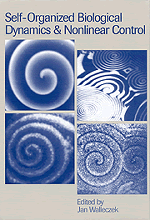 Self-Organized Biological Dynamics and Nonlinear Control
Self-Organized Biological Dynamics and Nonlinear Control Book contents
- Frontmatter
- Contents
- List of contributors
- Preface
- The frontiers and challenges of biodynamics research
- Part I Nonlinear dynamics in biology and response to stimuli
- Part II Nonlinear sensitivity of biological systems to electromagnetic stimuli
- 6 Electrical signal detection and noise in systems with long-range coherence
- 7 Oscillatory signals in migrating neutrophils: effects of time-varying chemical and electric fields
- 8 Enzyme kinetics and nonlinear biochemical amplification in response to static and oscillating magnetic fields
- 9 Magnetic field sensitivity in the hippocampus
- Part III Stochastic noise-induced dynamics and transport in biological systems
- Part IV Nonlinear control of biological and other excitable systems
- Index
8 - Enzyme kinetics and nonlinear biochemical amplification in response to static and oscillating magnetic fields
Published online by Cambridge University Press: 14 August 2009
- Frontmatter
- Contents
- List of contributors
- Preface
- The frontiers and challenges of biodynamics research
- Part I Nonlinear dynamics in biology and response to stimuli
- Part II Nonlinear sensitivity of biological systems to electromagnetic stimuli
- 6 Electrical signal detection and noise in systems with long-range coherence
- 7 Oscillatory signals in migrating neutrophils: effects of time-varying chemical and electric fields
- 8 Enzyme kinetics and nonlinear biochemical amplification in response to static and oscillating magnetic fields
- 9 Magnetic field sensitivity in the hippocampus
- Part III Stochastic noise-induced dynamics and transport in biological systems
- Part IV Nonlinear control of biological and other excitable systems
- Index
Summary
Introduction
The use of magnetic fields as a tool for influencing biological processes, which historically began with attempts to treat human disease, has had a long but checkered record. For many centuries following the discovery of the naturally magnetic material, magnetite (Fe2O3), the purported effects associated with this material were surrounded by superstition. In the first century AD, Pliny the Elder wrote about the apparently magical powers of ‘lodestone’, as magnetite was called then, such as the ability to heal the sick. The credible, scientific study of the biological effects of magnetism, however, has begun only in this century, and only in the 1960s were the first surveys of the laboratory evidence published (Barnothy, 1964, 1969).
Beginning in the 1970s, it was established that several animal species such as pigeon, salmon and honey bee were sensitive to even weak magnetic fields such as that of the Earth (for an overview, see Kobayshi and Kirschvink, 1995). This represents a remarkable sensitivity, since the magnetic flux density (B) of the Earth's magnetic field measured in units of tesla (T) is only about 50 microtesla (μT). For comparison, the magnetic field associated with a small, 1-cm toy magnet would be 1000-fold greater, for example, B≃50 millitesla (mT). In elegantly designed studies, scientists revealed that pigeons, salmon and bees were capable of sensing geomagnetic field lines as a way to orient themselves in their environment. The discovery of small amounts of magnetite in the biological tissue of these animals pointed to the role of magnetite as a potential element of a biological ‘compass’ for magneto-orientation.
- Type
- Chapter
- Information
- Self-Organized Biological Dynamics and Nonlinear ControlToward Understanding Complexity, Chaos and Emergent Function in Living Systems, pp. 193 - 215Publisher: Cambridge University PressPrint publication year: 2000
- 3
- Cited by
